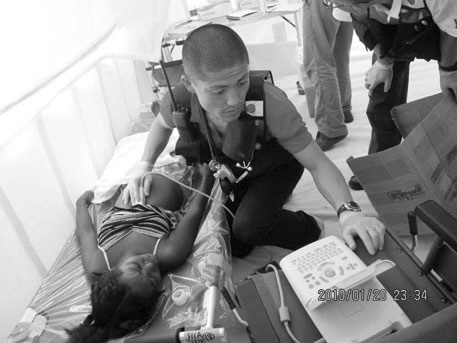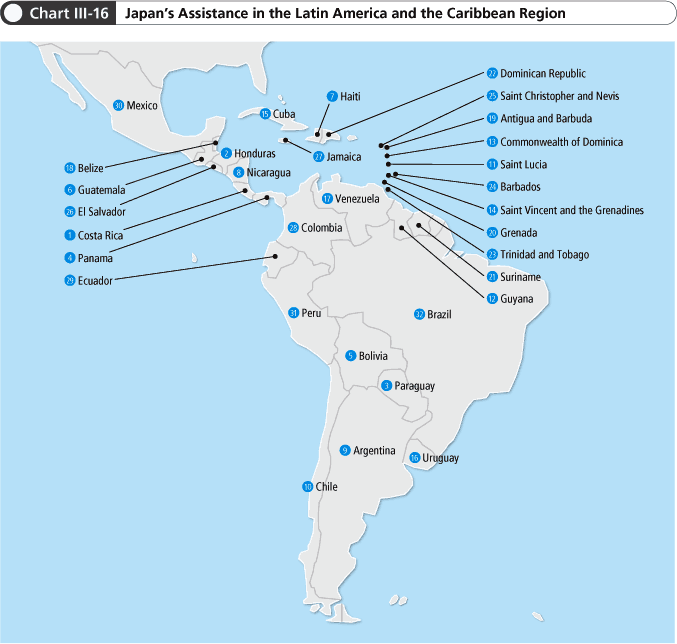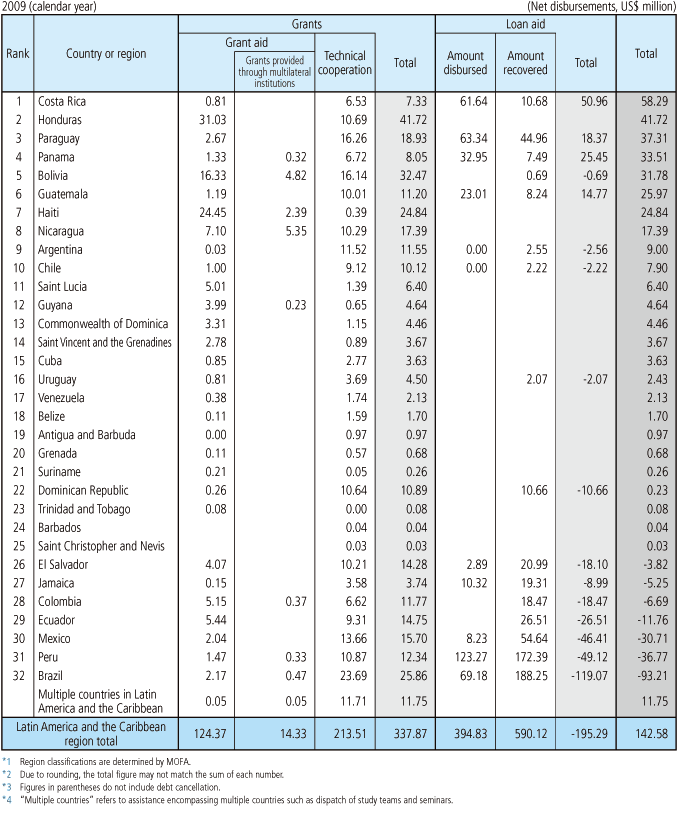Japan's Official Development Assistance White Paper 2010
6. Latin America and the Caribbean
Latin America and the Caribbean boast a population of 570 million with a large market of US$4.2 trillion in regional gross production. The region is also increasing its presence within the international community through the establishment of democracy and continuing stable growth, in addition to its role as a provider of minerals and energy resources, such as steel, copper, silver, rare metals, crude oil, natural gas, biofuels, as well as food resources. The average income level of countries in the region is comparatively high compared to other ODA recipient countries; however, a characteristic of this region is the marked domestic disparity between the rich and poor classes and continued existence of poverty. Moreover, efforts to address climate change have also become important as the region has an abundance of nature, including the Amazon Rainforest.
<Japan’s Efforts>
Japan and the countries of Latin America have traditionally created a friendly relationship, and through ODA, Japan provides support for meeting their challenges such as creating a foundation for sustainable growth, assistance for reducing poverty and redressing disparity, support for the consolidation of peace, and South-South Cooperation. Japan’s assistance for sustainable growth in the region consists of activities such as infrastructure development and cultivating small to medium-sized private enterprises. In addition, Japan also provides assistance in such social development sectors as health and medical care, education, and community development in order to tackle poverty and income disparity, which are historical issues of the region. Japan also supports the consolidation of peace in areas such as Haiti, the poorest country in the Western Hemisphere, and Colombia, which faces the issue of maintaining peace with antigovernment forces.
As for common development issues throughout the Latin America and Caribbean region, Japan creates region-wide projects while working together with regional communities such as the Sistema de la Integración Centroamericana (SICA), Mercado Común del Sur (MERCOSUR), and the Caribbean Community (CARICOM) in order to implement more effective and efficient assistance policies. Many years of continued economic cooperation disbursements by Japan have also allowed it to partner with Chile, Brazil, Argentina, and Mexico — which have all reached a level where they can provide assistance to third-countries — to conduct such efforts as third-country training and dispatching third-country experts in Latin American and African countries. In particular, Japan works together with Brazil in order to promote agricultural development projects in Mozambique.
In addition to deforestation and degradation in the Amazon, other environmental problems are worsening in Latin America and the Caribbean, such as the growing hole in the ozone layer, declining glaciers in the Andes caused by climate change, and frequent natural disasters such as hurricanes. Japan provides assistance for natural environment conservation and disaster prevention in order to restrain these problems and mitigate their impacts.
Japan works to spread the Japanese standard of digital broadcasting (ISDB-T) in cooperation with the Japanese public and private sectors. Particularly in Latin America, this standard has been spreading. Brazil adopted the standard in 2006. Then, as the result of the collaboration with Brazil on this matter, Peru, Argentina, Chile, and Venezuela made the decision to introduce this standard in 2009, followed by Ecuador, Costa Rica, Paraguay, Bolivia, and Uruguay in 2010. The promotion of Japanese digital broadcasting helps to improve regional broadcasting media, and the diffusion of Japanese standards can also help Japanese enterprises enter overseas markets. Japan supports these countries through technology transfer and human resource development.
Moreover, Haiti suffered massive damage from an earthquake that occurred in January 2010. In response to this, Japan dispatched Japan Disaster Relief Teams and Self-Defense Force units immediately after the earthquake hit; provided assistance in the health and medical sectors through international organizations; supplied food, water, and shelter; and provided assistance to the victims through Japanese NGOs. Moreover, with a view to medium to long-term reconstruction assistance, Japan utilizes its experience and knowledge as a country that has been the victim of earthquake disasters. For the national reconstruction of Haiti, Japan provides assistance that focuses mainly on the areas of education and human resource development, health and medical care, and food and agriculture.
●Japan's emergency Assistance to Haiti. see The Major Earthquake in Haiti
In addition, Japan supplied emergency relief goods such as generators and tents to Chile, which suffered damage from an earthquake that struck in February 2010. It also supplied emergency grant aid, such as medical equipment and temporary hospital facilities.

Medical technician examining the heart functions using an echocardiogram (Photo: JICA)


●Nicaragua: Project for Construction of the Santa Fe Bridge
Nicaragua is located roughly in the center of the Central American region, which seeks to enhance regional economic integration, and constitutes a critical passageway for the migration of people and goods within the region. But the development of the road network within the country is still inadequate, and its major throughway connecting it to its southern neighbor of Costa Rica is overly dependent on the route on the Pacific Ocean side. Therefore, Japan is moving forward with the construction of the Santa Fe Bridge near the border with Costa Rica in order to promote the development of a route on the Caribbean Ocean side through grant aid that is limited to ¥2,753 million. To date, Japan has supported the construction of bridges in Nicaragua, and has played a major role in stimulating the economy of Central America as a whole and improving the lives of the residents. Not only that, such bridges have received widespread high praise from the residents, such as for their high level of safety in terms of not sustaining any injuries from Hurricane Mitch, which brought about massive damage in 1998.
